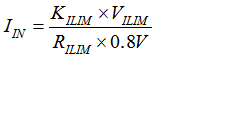ZHCSJ56C February 2018 – September 2019 BQ25882
PRODUCTION DATA.
- 1 特性
- 2 应用
- 3 说明
- 4 修订历史记录
- 5 Device Comparison Table
- 6 Pin Configuration and Functions
- 7 Specifications
-
8 Detailed Description
- 8.1 Overview
- 8.2 Functional Block Diagram
- 8.3
Feature Description
- 8.3.1 Device Power-On-Reset
- 8.3.2 Device Power Up from Battery without Input Source
- 8.3.3 Device Power Up from Input Source
- 8.3.4 Input Current Optimizer (ICO)
- 8.3.5 Buck Mode Operation from Battery (OTG)
- 8.3.6 Power Path Management
- 8.3.7 Battery Charging Management
- 8.3.8 Integrated 16-Bit ADC for Monitoring
- 8.3.9 Status Outputs (PG, and INT)
- 8.3.10 Input Current Limit on ILIM Pin
- 8.3.11 Voltage and Current Monitoring
- 8.3.12 Thermal Regulation and Thermal Shutdown
- 8.3.13 Battery Protection
- 8.3.14 Serial Interface
- 8.4 Device Functional Modes
- 8.5
Register Maps
- 8.5.1 Battery Voltage Regulation Limit Register (Address = 00h) [reset = A0h]
- 8.5.2 Charger Current Limit Register (Address = 01h) [reset = 54h]
- 8.5.3 Input Voltage Limit Register (Address = 02h) [reset = 85h]
- 8.5.4 Input Current Limit Register (Address = 03h) [reset = 39h]
- 8.5.5 Precharge and Termination Current Limit Register (Address = 04h) [reset = 22h]
- 8.5.6 Charger Control 1 Register (Address = 05h) [reset = 9Dh]
- 8.5.7 Charger Control 2 Register (Address = 06h) [reset = 7Dh]
- 8.5.8 Charger Control 3 Register (Address = 07h) [reset = 0Ah]
- 8.5.9 Charger Control 4 Register (Address = 08h) [reset = 0Dh]
- 8.5.10 OTG Control Register (Address = 09h) [reset = F6h]
- 8.5.11 ICO Current Limit Register (Address = 0Ah) [reset = XXh]
- 8.5.12 Charger Status 1 Register (Address = 0Bh) [reset = XXh]
- 8.5.13 Charger Status 2 Register (Address = 0Ch) [reset = XXh]
- 8.5.14 NTC Status Register (Address = 0Dh) [reset = 0Xh]
- 8.5.15 FAULT Status Register (Address = 0Eh) [reset = XXh]
- 8.5.16 Charger Flag 1 Register (Address = 0Fh) [reset = 00h]
- 8.5.17 Charger Flag 2 Register (Address = 10h) [reset = 00h]
- 8.5.18 FAULT Flag Register (Address = 11h) [reset = 00h]
- 8.5.19 Charger Mask 1 Register (Address = 12h) [reset = 00h]
- 8.5.20 Charger Mask 2 Register (Address = 13h) [reset = 00h]
- 8.5.21 FAULT Mask Register (Address = 14h) [reset = 00h]
- 8.5.22 ADC Control Register (Address = 15h) [reset = 30h]
- 8.5.23 ADC Function Disable Register (Address = 16h) [reset = 00h]
- 8.5.24 IBUS ADC 1 Register (Address = 17h) [reset = 00h]
- 8.5.25 IBUS ADC 0 Register (Address = 18h) [reset = 00h]
- 8.5.26 ICHG ADC 1 Register (Address = 19h) [reset = 00h]
- 8.5.27 ICHG ADC 0 Register (Address = 1Ah) [reset = 00h]
- 8.5.28 VBUS ADC 1 Register (Address = 1Bh) [reset = 00h]
- 8.5.29 VBUS ADC 0 Register (Address = 1Ch) [reset = 00h]
- 8.5.30 VBAT ADC 1 Register (Address = 1Dh) [reset = 00h]
- 8.5.31 VBAT ADC 0 Register (Address = 1Eh) [reset = 00h]
- 8.5.32 VSYS ADC 1 Register (Address = 1Fh) [reset = 00h]
- 8.5.33 VSYS ADC 0 Register (Address = 20h) [reset = 00h]
- 8.5.34 TS ADC 1 Register (Address = 21h) [reset = 00h]
- 8.5.35 TS ADC 0 Register (Address = 22h) [reset = 00h]
- 8.5.36 TDIE ADC 1 Register (Address = 23h) [reset = 00h]
- 8.5.37 TDIE ADC 0 Register (Address = 24h) [reset = 00h]
- 8.5.38 Part Information Register (Address = 25h) [reset = 11h]
- 9 Application and Implementation
- 10Power Supply Recommendations
- 11Layout
- 12器件和文档支持
- 13机械、封装和可订购信息
8.3.10 Input Current Limit on ILIM Pin
For safe operation, the device has an additional hardware pin on ILIM to limit maximum input current. The maximum input current is set by a resistor from ILIM pin to ground as:

The actual input current limit is the lower value between ILIM pin setting and register setting (IINDPM). For example, if the register setting is 3.3 A (0x1C), and ILIM has a 820-Ω resistor to ground, the input current limit is 1.43 A (KILIM = 1170 max). ILIM pin can be used to set the input current limit rather than the register settings when EN_ILIM bit is set. The device regulates ILIM pin at 0.8 V. If ILIM voltage exceeds 0.8 V, the device enters input current regulation (refer to Dynamic Power Management section). Entering IINDPM through ILIM pin sets the IINDPM_STAT and FLAG bits, and produces an interrupt to host. The interrupt can be masked via the IINDPM_MASK bit.
The ILIM pin can also be used to monitor input current when EN_ILIM is set and the device is not in ILIM regulation. The voltage on ILIM pin is proportional to the input current. ILIM can be used to monitor input current with the following relationship:

For example, if ILIM pin is set with 820-Ω resistor, and the ILIM voltage 0.5 V, the actual input current is 0.762 A to 0.892 A (based on KILIM specified). If ILIM pin is open, the input current is limited to zero since ILIM voltage floats above 0.8 V. If ILIM pin is shorted, the input current limit is set by the register.
The ILIM pin function can be disabled by setting the EN_ILIM bit to 0. When the pin is disabled, both input current limit function and monitoring function are not available.